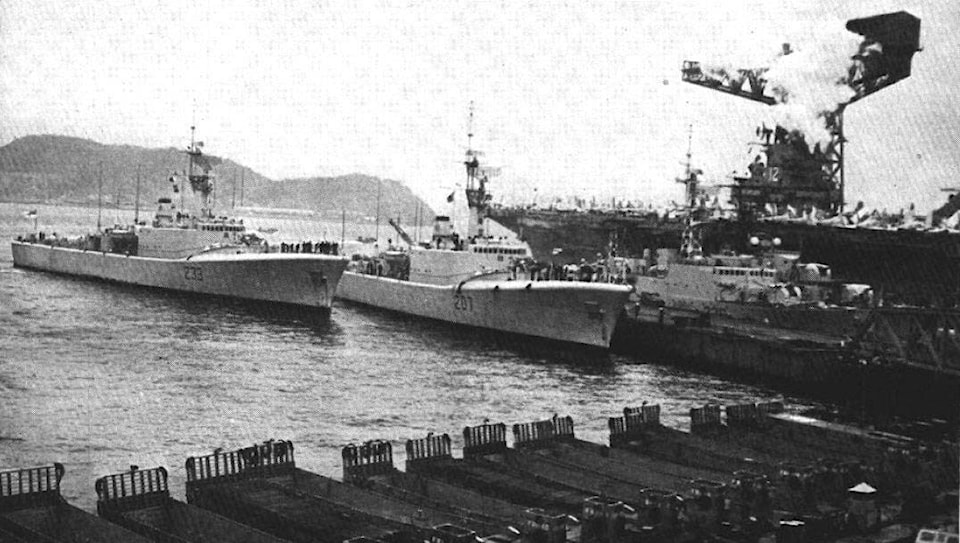They were unique for their day for their “dramatically different hull form”. This was in recognition of the new atomic age.
According to the latest report (as of two weeks ago) the federal procurement program to replace Canada’s all-but-gone surface ships, both fighting and supply, is back onstream.
It’s been a rough voyage to date and we’ve a long way to go to restore the Royal Canadian Navy to full fighting trim.
All of which reminded me of the time when Canada, ever so briefly, had a fleet of warships that were the envy of its allies, known to American sailors as Cadillacs of the seas.
I’m referring to the 1950s-era St. Laurent class of destroyer escorts, or DDE’s, which were later converted to destroyer helicopter escorts, or DDH’s.
In 1949 — this was the immediate postwar era — Canada appeared to be poised to throw off the last vestiges of colonialism and its hewers-of-wood-and-water subservience to the United States. Canadian scientists and engineers had designed the most advanced fighter plane in the world, the Avro Arrow. And the Canadian government had authorized the construction of the first major class of warship to be designed and built in Canada.
The seven St. Laurent-class DDE’s weren’t entirely ‘made in Canada,’ as they were based upon the British Type 12 Whitby-class frigate and used the same machinery, and they were equipped with American equipment. That said, only the St. Laurent’s propulsion system was built in Britain, the other ships being powered by Canadian-manufactured machinery.
Where they stood out as unique for their day was their “dramatically different hull form” (Wikipedia). For the first time, destroyers lost their rakish but sheer lines, replaced by a rounded-off hull and a continuous main deck which was particularly noticeable at the bow. This was in recognition of the new atomic age. The contoured profile was designed to discourage ice build-up (a curse of the recent war in the North Atlantic) and, in wartime, to shed radioactive, chemical and biological residue; these to be washed away by the sea and by a decontaminating spray system. As a further precaution, much of the ship could be hermetically sealed when under attack.
Two human touches were the installation of bunks for crewmembers in place of the traditional hammocks, and air conditioning.
There was no mistaking HMCS St. Laurent and her sisters, Saguenay, Skeena, Fraser, Ottawa, Margaree and Assiniboine, all of whom were named in honour of the RCN’s most battle-honoured destroyers of the Second World War, from their predecessors and other navies’ ships.
Other innovative features included an operations room separate from the bridge, where the captain commanded the ship while in combat, 12 separate internal telephone systems and the latest advances in radar and sonar (submarine detection) technology. The latter, and later, consideration, known as variable depth sonar, required a major restyling of the stern section.
Originally, there were to be 14 St. Laurent-class ships built over five years. But rapidly changing technology and the deepening Cold War between the Soviet Union and western nations initiated major weaponry upgrades. These were incorporated in a second set of seven ships which became the Restigouche-class. Four Mackenzie-class ships followed, 1962-63, and the last of the series, two of the Annapolis-class, in 1964.
By this time all were being built as helicopter carrying destroyer escorts, the original St. Laurent-class having been converted. All these years later, all of these destroyers are gone but some Sea King helicopters which had been specifically chosen to augment their anti-submarine capabilities are yet in service.
Warships don’t last forever and, by the 1970s, 10 of the St. Laurent-class destroyers were given mid-life extensions with new electronics, machinery and hull upgrades — just enough to keep them going into the ’80s. But St. Laurent, the dowager queen, received even less — just repairs to her hull and machinery. She was the first to be paid off, in June 1974, and she died ignominiously at the end of a towline while en route to a scrapyard.
Decommissioning of the others followed: Assiniboine, 1988; Saguenay, 1990; Margaree and Ottawa, 1992; Skeena, 1993; Fraser, 1994.
I told you that the St. Laurents were noteworthy — so much so that, in 1997, the Historic Sites and Monuments Board of Canada recognized them as being historically significant and attached a bronze plaque to HMCS Fraser as she awaited final disposition:
“St. Laurent Class of Canadian Warships
“The pride of the Canadian Navy during the Cold War, these anti-submarine escorts were the first naval vessels conceived and built in Canada. Designed in 1948-1949, they influenced naval construction internationally with their smooth above-water surfaces and distinctive convex deck.
“They also could be sealed to protect crews against biological and radioactive threats. All seven St. Laurent-class ships were modified during the 1960s to carry helicopters and enhance their anti-submarine capability. Launched in 1953, HMCS Fraser is the last surviving example of this innovative class of warship.”
